Taiwan gained insight into the Latin aphorism ars longa, vita brevis (art is long, life is short) with LAB Space’s recent production of Tuesdays with Morrie. Directed by Taiwan-based impresario Brook Hall, the play, like the well-known memoir of the same name, treats the relationship of sports writer Mitch Albom and his former professor Morrie Schwartz as the latter faces death. Taiwan, however, got more than just a play in that process; it got an intriguing look into the symbiotic relationships that exist between art, life and serendipity.
Start with the book and biography. Certainly, no one will deny how autobiographical and biographical elements can run through art and fiction. Many of Hemingway’s novels, for example, draw both upon his and the life experiences of his friends for background.
The play differs from the book. In drama, since each production varies in director and cast, the impact will also be different. Taiwan’s production of the play had this one extra feature — Rob Schwartz, the son of Morrie Schwartz, attended performances in the last week and stayed to answer audience questions, biographical and otherwise.

Photo courtesy of Tobie Openshaw
Intermixed is serendipity. Rob Schwartz made a point of using that word in one of his answers. Working in Tokyo as Bureau Chief of Billboard Magazine, he learned of Taiwan’s production via a Facebook posting and volunteered to visit. Serendipity played a big part in the writing of the book as well. If Mitch Albom had not been channel surfing at the time he would not have learned of the debilitating condition of Morrie from Ted Koppel’s Nightline. He would also probably not have had the time for the 14 Tuesday visits with Morrie before his death except that Albom’s paper was on strike freeing up his schedule.
For his part, Hall says he was influenced by the book and wanted LAB Space to be known for more than comedies. He also had the constraints of the small theater space requiring plays with a minimal cast and he had in mind a well-known entertainer, DC Rapier, to fit the lead role. Rapier read the book and was moved by both it and the play, but the lines of the play perhaps had more impact since a friend of his had just died and Rapier himself had had a somewhat life-threatening operation. Victor Stevenson, who played Mitch, used the illness and death of his own father to help identify with his role. He and Rapier developed the needed chemistry for the play.
Rob Schwartz brought other elements in. What was it like growing up with his father? How did the family feel about Mitch? When the Schwartz family sold the house made famous by the book, his mother refused to let that be part of the advertisement, though it would have increased the value. A best seller? Several publishers had originally refused the book; it did not take off until Oprah endorsed it. Did that make it art or more what the general public wanted or both? Some people might have liked the book less if they knew of the left wing politics of Rob’s father. That element was purposely left out. And of course there were unrelated questions like, what do you feel about Doraemon?
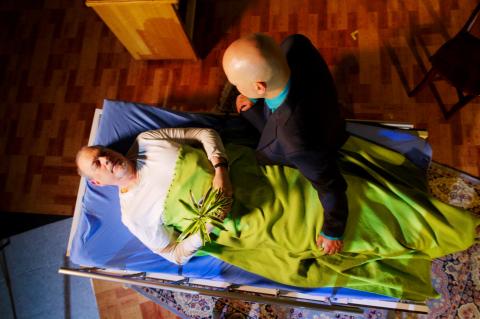
Photo courtesy of Tobie Openshaw
The book allows for pauses and rereading; the play is bounded by a brief time span for digestion but it is live. Those who had read the memoir could make their own judgments. Rob Schwartz obviously preferred the book; it dealt with his father’s life and thought. This writer preferred the play, perhaps because the drama made the learning and change in Albom’s writing direction more poignant. Having read the book nearly a decade ago, the only specific remembrance is how Albom symbolically brought food that Morrie Schwartz could no longer eat.
Morrie Schwartz died before Albom’s book on his final “class” hit bookshelves; he would never know the full reach of the work and certainly could not have envisioned the play being shown in Taiwan. Life, reality, art, serendipity and memoir; it is all here and the LAB Space as community theater is part of it. For future projects by LAB Space, go to www.facebook.com/labspacetw.
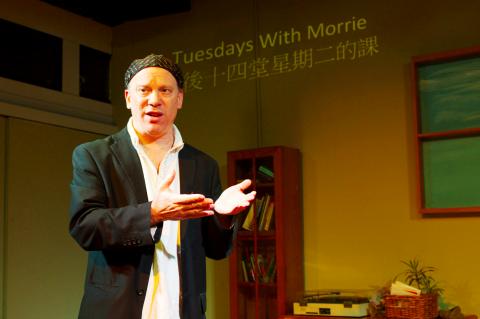
Photos courtesy of Tobie Openshaw
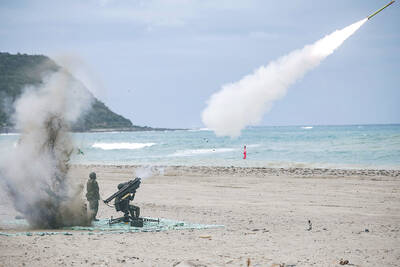
In late October of 1873 the government of Japan decided against sending a military expedition to Korea to force that nation to open trade relations. Across the government supporters of the expedition resigned immediately. The spectacle of revolt by disaffected samurai began to loom over Japanese politics. In January of 1874 disaffected samurai attacked a senior minister in Tokyo. A month later, a group of pro-Korea expedition and anti-foreign elements from Saga prefecture in Kyushu revolted, driven in part by high food prices stemming from poor harvests. Their leader, according to Edward Drea’s classic Japan’s Imperial Army, was a samurai
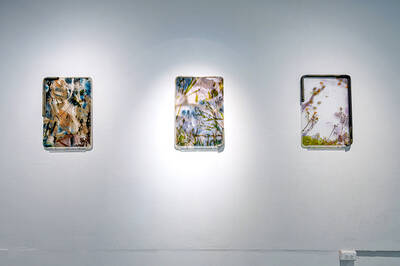
Located down a sideroad in old Wanhua District (萬華區), Waley Art (水谷藝術) has an established reputation for curating some of the more provocative indie art exhibitions in Taipei. And this month is no exception. Beyond the innocuous facade of a shophouse, the full three stories of the gallery space (including the basement) have been taken over by photographs, installation videos and abstract images courtesy of two creatives who hail from the opposite ends of the earth, Taiwan’s Hsu Yi-ting (許懿婷) and Germany’s Benjamin Janzen. “In 2019, I had an art residency in Europe,” Hsu says. “I met Benjamin in the lobby
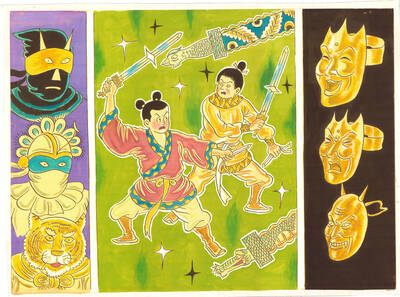
April 22 to April 28 The true identity of the mastermind behind the Demon Gang (魔鬼黨) was undoubtedly on the minds of countless schoolchildren in late 1958. In the days leading up to the big reveal, more than 10,000 guesses were sent to Ta Hwa Publishing Co (大華文化社) for a chance to win prizes. The smash success of the comic series Great Battle Against the Demon Gang (大戰魔鬼黨) came as a surprise to author Yeh Hung-chia (葉宏甲), who had long given up on his dream after being jailed for 10 months in 1947 over political cartoons. Protagonist

A fossil jawbone found by a British girl and her father on a beach in Somerset, England belongs to a gigantic marine reptile dating to 202 million years ago that appears to have been among the largest animals ever on Earth. Researchers said on Wednesday the bone, called a surangular, was from a type of ocean-going reptile called an ichthyosaur. Based on its dimensions compared to the same bone in closely related ichthyosaurs, the researchers estimated that the Triassic Period creature, which they named Ichthyotitan severnensis, was between 22-26 meters long. That would make it perhaps the largest-known marine reptile and would